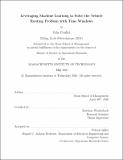| dc.contributor.advisor | Matthias Winkenbach. | en_US |
| dc.contributor.author | Poullet, Julie(Julie M.) | en_US |
| dc.contributor.other | Massachusetts Institute of Technology. Operations Research Center. | en_US |
| dc.date.accessioned | 2020-09-15T21:50:16Z | |
| dc.date.available | 2020-09-15T21:50:16Z | |
| dc.date.copyright | 2020 | en_US |
| dc.date.issued | 2020 | en_US |
| dc.identifier.uri | https://hdl.handle.net/1721.1/127285 | |
| dc.description | Thesis: S.M., Massachusetts Institute of Technology, Sloan School of Management, Operations Research Center, May, 2020 | en_US |
| dc.description | Cataloged from PDF version of thesis. | en_US |
| dc.description | Includes bibliographical references (pages 111-125). | en_US |
| dc.description.abstract | The Vehicle Routing Problem with Time Windows (VRPTW) has been widely studied in the Operations Research (OR) literature given its increasingly widespread applications, ranging from school bus scheduling to packages delivery. In the last decades, and in large part due to the surge in e-commerce and shortened promised lead times, the scale of the highly constrained VRPTW instances encountered in real-world applications has significantly increased. Simultaneously, various Machine Learning (ML) methods have been developed to tackle combinatorial problems and to leverage complex data structure, but little research has been done on applying these techniques to the VRPTW. In light of this research gap, our thesis develops a process to solve large-scale VRPTW without classical OR routing by proposing a two-stage algorithm. In the first stage, we design a clustering algorithm leveraging Optimal Classification Trees (OCT), which aims at dividing customers into smaller subsets. In the second stage, we present an actor-critic Reinforcement Learning (RL) approach to solve the VRPTW on these smaller customers clusters. Subsequently, we explore the interactions between ML and OR and develop a framework to overcome the difficulties linked to the differences between the train and test sets, as well as the adversity created by the OR algorithm. We also study the generalization limitations of RL methods. Results show that the clustering approach is competitive with regards to a k-means-based clustering, yielding improvements up to 5% in terms of number of vehicles, and that a RL approach can successfully solve medium-size VRPTW instances, providing optimality results similar to state-of-the-art industrial solvers. | en_US |
| dc.description.statementofresponsibility | by Julie Poullet. | en_US |
| dc.format.extent | 125 pages | en_US |
| dc.language.iso | eng | en_US |
| dc.publisher | Massachusetts Institute of Technology | en_US |
| dc.rights | MIT theses may be protected by copyright. Please reuse MIT thesis content according to the MIT Libraries Permissions Policy, which is available through the URL provided. | en_US |
| dc.rights.uri | http://dspace.mit.edu/handle/1721.1/7582 | en_US |
| dc.subject | Operations Research Center. | en_US |
| dc.title | Leveraging machine learning to solve The vehicle Routing Problem with Time Windows | en_US |
| dc.title.alternative | Leveraging machine learning to solve VRPTW | en_US |
| dc.type | Thesis | en_US |
| dc.description.degree | S.M. | en_US |
| dc.contributor.department | Massachusetts Institute of Technology. Operations Research Center | en_US |
| dc.contributor.department | Sloan School of Management | |
| dc.identifier.oclc | 1191849628 | en_US |
| dc.description.collection | S.M. Massachusetts Institute of Technology, Sloan School of Management, Operations Research Center | en_US |
| dspace.imported | 2020-09-15T21:50:16Z | en_US |
| mit.thesis.degree | Master | en_US |
| mit.thesis.department | Sloan | en_US |
| mit.thesis.department | OperRes | en_US |
